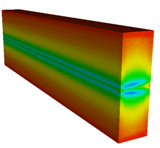Speaker
Alexander RYAZANOV
(KURCHATOV INSTITUTE)
Description
Theoretical models and numerical calculations are presented here to understand an influence of the
impact of a 7 TeV proton beam on the physical-mechanical properties of collimator materials (C, Cu) used
in the LHC. Here we develop the theoretical model for shock wave propagation and theoretical model for calculations
of primary radiation damage formation including calculations of a generation rate of point defects and atomic
cascades in collimator materials under 7 TeV proton beam irradiation. In our calculations we assume that each
7 TeV proton bunch has 1.1x1011 protons with a bunch length of 0.5 ns and a bunch spacing of 25 ns. The high
energy stored in each bunch can produce a shock wave and radiation damage near the impacting proton beam in these materials.
The theoretical model for the investigations of shock wave propagation in the collimator materials takes into
account ionization, electronic excitation, and energy transfer from excited electronic subsystem of material
to the ionic subsystem. The changes of some physical properties of the collimator materials during shock
wave propagation are considered here. The deposited energy is calculated with the FLUKA program.
The numerical results of the microstructure changes in collimator materials produced by shock wave propagation
near 7 TeV proton beam are presented for different numbers of bunches. This allows investigating changes of
density and internal pressure, the distributions of atomic and sound velocities, and the temperature profiles in
electronic and ionic subsystems of materials near the front of shock wave. These results are very relevant
for the understanding the behavior of collimator materials used in LHC when hit by a 7 TeV proton beam.
The new theoretical models and computer tools are developed for investigations of radiation damage
formation: point defects, cascades and sub-cascades near a 7 TeV proton beam in collimator materials: Cu and
Graphite, taking into account electronic excitation, energy loss, elastic and inelastic collisions in materials
induced by interaction of 7 TeV proton beam with collimator materials. The numerical calculations for generation
rates of point defects are based on the numerical calculations of displacement cross sections for point defect
production taking into account primary knocked atom (PKA) energy spectra for nuclear products and neutron
spectrum near 7 TeV proton beam obtained using FLUKA program.
Co-authors: SEMENOV E.v. (Kurchatov Institute), KOZLOVA O.a. (Kurchatov Institute), ASSMANN Ralph (CERN), FERRARI Alfredo (CERN), SCHMIDT Rudiger (CERN)
Primary author
Alexander RYAZANOV
(KURCHATOV INSTITUTE)
Co-authors
Alfredo FERRARI
(CERN)
E.V. SEMENOV
(KURCHATOV INSTITUTE)
O.A. KOZLOVA
(KURCHATOV INSTITUTE)
Ralph ASSMANN
(CERN)
Rudiger SCHMIDT
(CERN)




